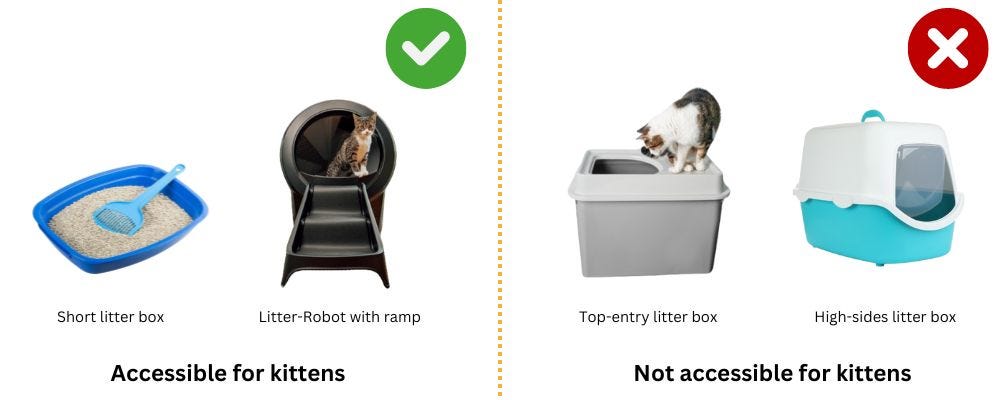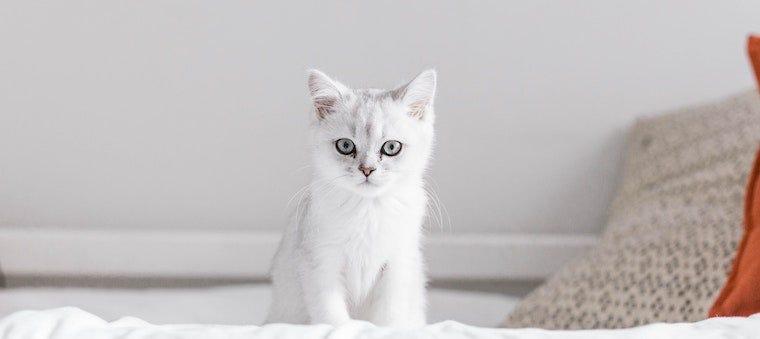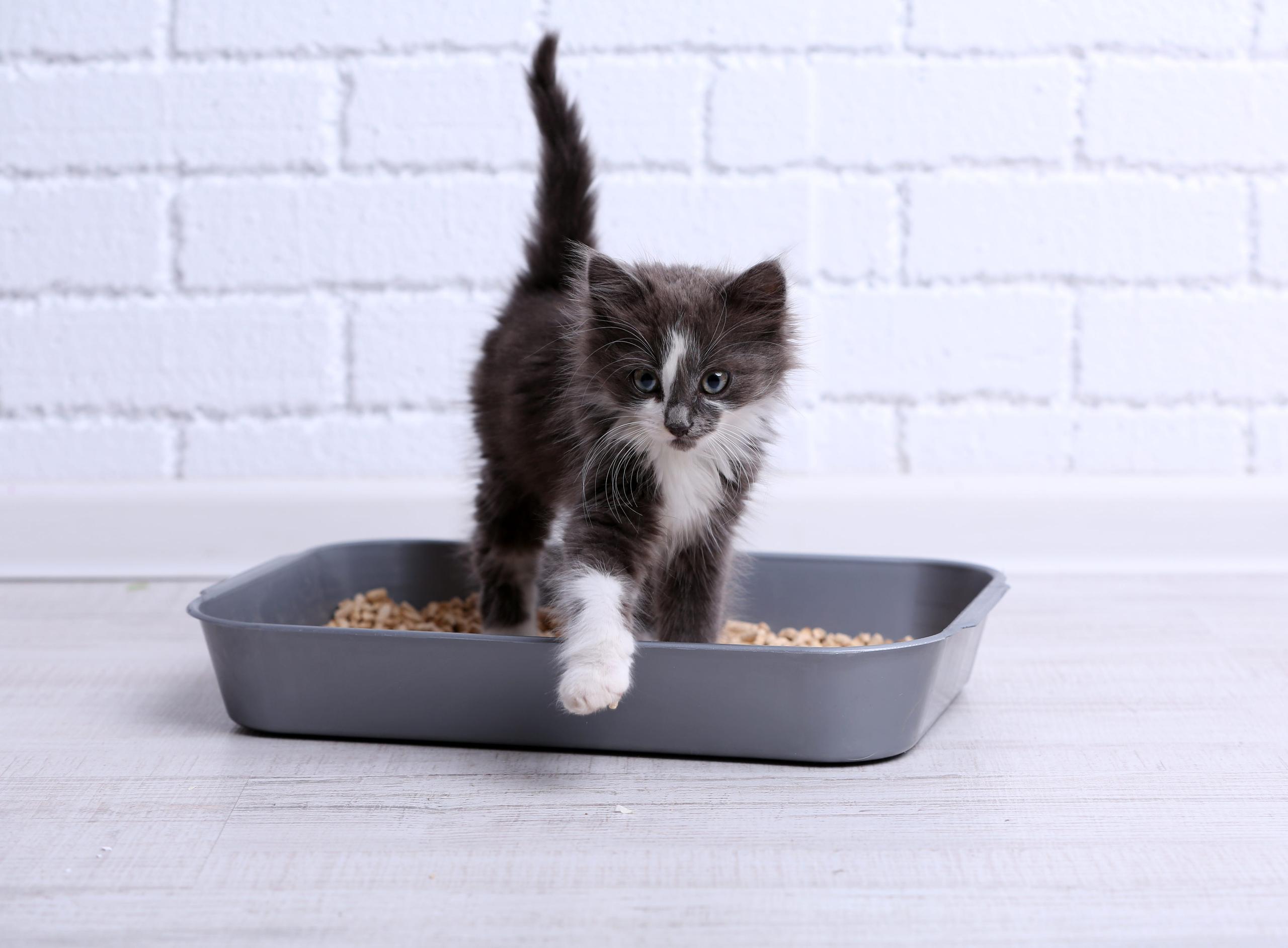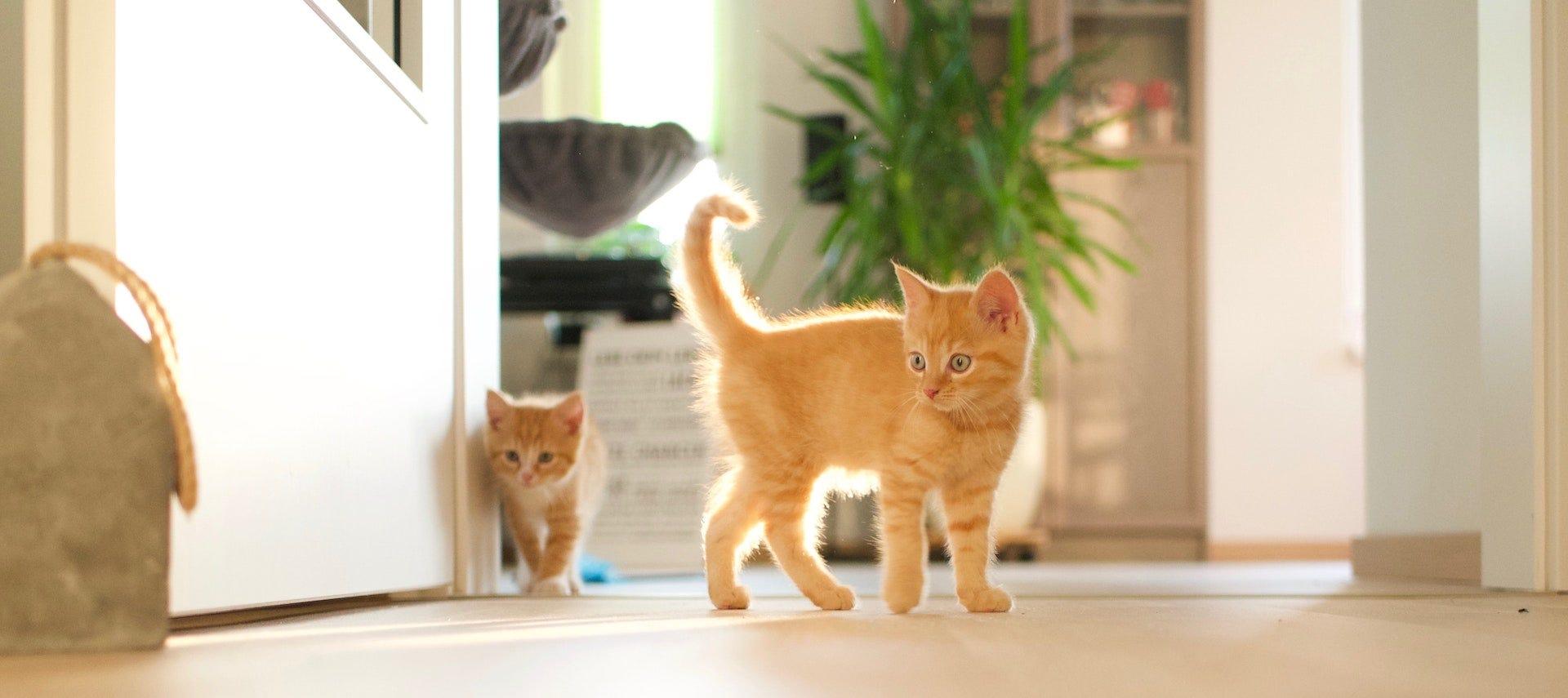Adopting a kitten is always exciting. But you have plenty to think about, from kitten litter box training to introducing the kitten to your resident cat—and choosing a kitten litter box is no exception. There are many options to choose from, depending on what you're looking for with a kitten litter box.
Before buying a litter box
Ideally, you should buy a litter box that your kitten can grow into and enjoy into adulthood. Researching and knowing what to expect can make training kittens to use litter boxes easier for you and your cat.
Before buying any litter box, ask yourself these questions:
- Was the kitten ever exposed to a litter box before?
- How big will my kitten get when they reach adulthood?
- Do I prefer an open or covered litter box?
- Will I need multiple litter boxes?
- Where will I place the litter box?
Knowing the answers to these questions will help you choose the best litter box for your kitten.
How big should a litter box for kittens be?

In general, vets recommend that the litter box is at least 1.5 times the length of your cat and at least 15 inches wide.
“A larger litter box is almost always going to be a cat’s preference. They want ample space to dig, turn around, and bury their excrement.” – Laria Herod, DVM
Here's a size guide to help you pick the best kitten litter box size based on your cat's age:
| Kitten age | Recommended litter box size | Type of litter box | Details |
| 0 - 4 weeks | N/A | None | Kittens under 4 weeks are usually not litter trained; they rely on their mother for cleanliness. Simply clean the area regularly. |
| 4 - 8 weeks | Small (12 x 9 inches) to Medium (16 x 12 inches) | Low-sided, open litter Box | Easy for young kittens to access; low sides help them enter and exit without difficulty. |
| 8 - 12 weeks | Medium (16 x 12 inches) | Low-sided, open litter box | Provides more space as they grow but still allows easy access. |
| 3 - 6 months | Medium to Large (18 x 14 inches) | High-sided, covered litter box, or self-cleaning litter box | Kittens are more agile; high sides or a covered box helps contain litter scatter and provides privacy. A self-cleaning litter box may also be appropriate if your cat reaches the minimum weight. |
| 6 months - 1 year | Large (20 x 16 inches or larger) | High-sided, covered litter box, or self-cleaning litter box | For larger, more active kittens; self-cleaning boxes reduce maintenance and are good for households with multiple pets. |
Kittens are small but will inevitably grow larger, so the ideal kitten litter box should be at least 15 inches by 9 inches so you don't have to change it after only a couple of weeks. This will accommodate their small size but be sufficient as they grow.
Regular litter box vs kitten litter box
While a regular litter box can sometimes do the trick, what's going to matter most in the early stages is accessibility. If you pick a litter box with high sides, your kitten might be unable to use it, hindering your litter box training.
On the other hand, buying a litter box for kittens at first and a larger one when they grow up can be counterproductive. Plus, cats are creatures of habit, meaning they can be reluctant to change anything, including their litter box.
At the end of the day, the best litter box for kittens is one they can grow into and keep using in the long term. Aim for a litter box that will be large enough to use when they grow up yet accessible to their smallest form. A good example is Litter-Robot 4, which offers easy accessibility with its optional ramp accessory, can be used with multiple cats, and has no maximum weight limit.
5 things to look for in a kitten litter box
Several factors should be considered when choosing a litter box that your kitten will enjoy for years to come. Let’s discuss some of these factors below.
Safety features
We cannot stress this enough: make sure that you read the fine print of your potential kitten litter box. Many litter boxes, including automatic ones, may not be compatible with kittens or underweight cats or may contain harmful products, potentially resulting in your cat getting hurt.
Unfortunately, many cheap automatic litter boxes do not provide appropriate safety features, especially for kittens. If your litter box has a weight limit, ensure it has other safety options available. A good feature of Litter-Robot is that you can switch to a semi-automatic setting, which is safe for kittens and cats under 3 pounds for Litter-Robot 4 and under 5 pounds for Litter-Robot 3 Connect.
Size and shape

It's important to choose a comfortable litter box, which can help make litter box training a kitten much easier on you. Instead of finding a litter box that looks nice or fits into a particular place in your home, you should base your litter box decision on what will be easier for your cat to use.
Matching the size of the litter box to the size of your kitten or cat can help encourage your cat to use it instead of your floor.
Choosing a design that is easy for your cat to climb in and out of is also helpful. If your cat isn’t comfortable getting into the litter box, they may be more likely to have accidents outside of the litter box.
Material
There are plenty of litter box options on the market these days, including varied shapes, sizes, and materials. When choosing a litter box, you’ll want to consider a durable material that lasts many years. Some cats may kick or scratch after using the litter box, and you’ll need a litter box that can take a beating.
Another factor to consider when choosing the right material for your kitten litter box is choosing a non-porous box. This can help keep your cat's urine from soaking into the litter box. If the material you choose is easily scratchable, it can allow your cat’s urine to soak into it, making it difficult to clean and nearly impossible to eliminate odors.
Litter box materials to avoid:
- Plastic with harmful chemicals. Choose litter boxes made from BPA-free plastic or other materials that do not contain harmful chemicals.
- Porous plastics. Certain types of plastics like polypropylene (PP), PVC, or acrylic can absorb the odors of urine and feces, making it difficult to eliminate smells even with regular cleaning.
- Cardboard or paper-based materials. Litter boxes made from cardboard or paper-based materials may absorb moisture and odors.
Convenience
It can be time-consuming and inconvenient to choose a non-automatic litter box. They require a lot of time and maintenance, not to mention the cat urine smell that typically lingers. Instead, it may be beneficial to upgrade to a litter box that can handle messes on its own and still allow your cat to grow with it.
Automatic litter boxes are available that clean your cat's waste after each use and deposit it into a discreet drawer. Not only does this help with time management, but it also helps to keep odors at bay.
Choosing kitten-safe litter
Because of their smaller size, delicate digestive system, and tendency to explore, kitten-safe litter is often the safer choice. Look for the following characteristics:
- Non-clumping (temporarily): Some kittens will eat small amounts of cat litter. If you cannot supervise your kitten, you may want to avoid using clumping litter, as it can cause intestinal blockages if eaten.
Clumping litter can cause intestinal blockages if eaten.
- Dust-free litter: Kittens are more sensitive to respiratory issues caused by dust. Choose a low-dust cat litter to minimize risks.
- Odor-neutralizing: Kittens have a keen sense of smell and a smelly litter box may deter them from using it. That said, scented cat litter can lead to negative results. Clean the litter frequently and choose unscented litter with odor-control properties.
- Easy to scoop: A dirty litter box can lead to health issues. Once your kitten is slightly older, use clay-clumping litter over pellet types for improved moisture retention and ease of cleaning.
It’s also important to note that some litter boxes require that you use a specific type of litter. You’ll want to ensure your kitten is comfortable with the litter you choose. If your kitten does not appear to like the type of litter required for a specific box, you may need to reconsider the litter box in your home.
According to a study conducted by vets, cats tend to prefer clay-clumping litter over silica or pellet litters.
For more litter box tips, read our full litter box guide.
Kitten litter box training tips

You can take steps to help ease your kitten into using their litter box. Training your kitten to use their litter box is typically easy, but can take time and patience.
1. Introduce your kitten to their litter box right away
When you first bring your kitten home, you should take them to their litter box right away. Place your kitten in their litter box and give them time to smell and inspect it. Once they appear comfortable with it, you shouldn’t move it from that location. Unless, of course, they are having accidents in another area of the home—then you can try to move the litter box to that area and encourage them to use it there instead.
2. Give them privacy
Some cats can be very picky about where their litter box is located. If the litter box is in an area that your cat is uncomfortable with, they may be less likely to use it and more likely to have accidents somewhere more private in your home. Privacy is very important to many cats, and keeping the litter box in a low-traffic area can encourage them to use their litter box instead of your floor.
3. Use treats or toys to encourage your kitten
When you see your kitten using their litter box, you can reward them with a small treat. Giving them a treat or some wet food can encourage them to continue using their litter box. Once your kitten is routinely using their litter box, you may have to slowly cut back the treats or food as a reward to keep them healthy.
Another option would be to reward your kitten with a new toy. Regardless of what you choose, remaining positive and praising them will assist with successfully training a kitten to use their litter box.
4. Do not punish your kitten for accidents
It can be difficult to remain positive if your kitten is not using their litter box. However, you should not punish or scold your kitten if an accident occurs. This can cause stress and anxiety in your kitten, which can lead to more accidents. If you notice your kitten is not using their litter box while you are trying to train them, you may need to investigate further to figure out if something else is going on.
The best kitten litter box option
Criteria to look for
In summary, a good litter box for kittens should have the following qualities:
- 2-3 inches entry height or with an access ramp
- Open design so the litter box is less intimidating and provides more visibility
- Smooth, rounded edges to ensure the kitten isn't injured while entering/exiting
- BPA free plastic or stainless steel litter box
Litter-Robot 4 - To get a cat to use a self-cleaning litter box from the start
Litter-Robot 4 is one of the best options when choosing a litter box for kittens. Having Litter-Robot 4 available when you bring your kitten home can help acclimate them to their new litter box.
Important: Litter-Robot senses when your cat enters and exits the globe, which triggers the countdown timer and cleaning cycle. Kittens and small cats that weigh less than 3 pounds (or 5 pounds for Litter-Robot 3 Connect) may not be heavy enough to trigger the cat sensor. Therefore, kittens and small cats that weigh less than 3 pounds can use Litter-Robot 4, but not in automatic mode.
Until they weigh enough, we recommend using your Litter-Robot in "semi-automatic" mode to keep your cat safe and relieve you from litter box scooping. For "semi-automatic" mode, leave Litter-Robot switched off or unplugged. When you see your kitten has used it, wait a few minutes for the waste to clump, then turn it on/plug it in. Litter-Robot will automatically perform a clean cycle (which takes about 2 ½ minutes). Afterward, turn it off/unplug it again. Continue this supervised, semi-automatic mode until your kittens have gained sufficient weight to activate the cat sensor.
Special features
Many features of Litter-Robot make it a great option for kittens and cats. Some of the special features of Litter-Robot include:
- Self-cleaning technology: Litter-Robot recognizes when your cat has used the litter box and sifts the waste into a drawer below the unit once your cat has exited. This ensures that your cat will always have a clean litter box to use.
- Connectivity with the app: This allows you to be notified when your cat has used the litter box and gain insight into their bathroom trends and behaviors. The app will also notify you when the waste drawer is full and needs to be emptied.
- Odor management: Litter-Robot will separate your cat's waste into a tightly sealed, carbon-filtered drawer once they are finished using the litter box. This helps to significantly reduce litter box odors and keep your house smelling fresh.
- Safety features: Using special sensors, Litter-Robot will detect when your cat is using the litter box and will inform you via the app or the unit if the unit stops working for any reason.
- Time and money saver: Litter-Robot has patented sifting technology that removes only the waste, leaving the clean litter for your cat. This can help save money on cat litter—and save you time with no longer having to scoop the litter box.
- Multi-cat households: If you have multiple cats in your household, Litter-Robot 4 is the best multi-cat self-cleaning litter box. Comfortably accommodating up to 4 cats and cleaning itself after each use, this automatic litter box is a great option if you plan on adding a new kitten to your household.
Choosing the best litter box for kittens
When deciding to bring a new kitten home, one of the most important decisions is choosing a litter box that works for both your kitten and your home. Training a kitten to use the litter box can take time and patience, so it’s helpful to choose a litter box that is easy to use, convenient, and durable. Not only does Litter-Robot 4 help keep odors away, it also helps save you time and money—making life easier for you and your new kitten! Just remember to leave Litter-Robot in semi-automatic mode until your kitten weighs 3 or 5 pounds, depending on the model.
Do I need a special litter box for kittens?
Not necessarily. However, you should choose a litter box that is easy for your kitten to use.
How often do kittens use the bathroom?
Kitten bathroom habits can vary greatly from one kitten to another. Typically, kittens should urinate every few hours and defecate at least once per day.
Why do kittens pee outside of the litter box?
It’s possible your kitten does not like their litter or litter box. It’s also possible that the litter box is located in a difficult-to-reach area. Make sure your kitten's litter box is easily accessible and clean. If that doesn’t work, you may need to reach out to your veterinarian for additional assistance.







